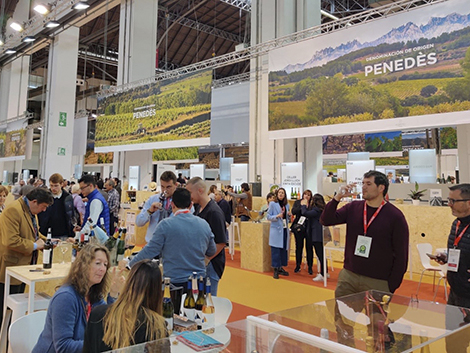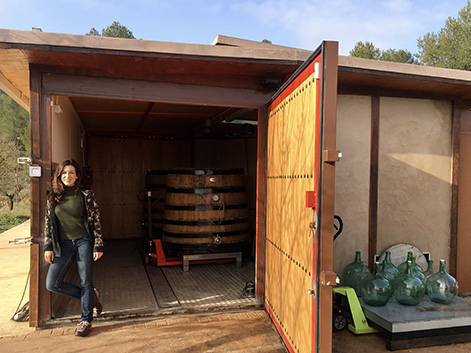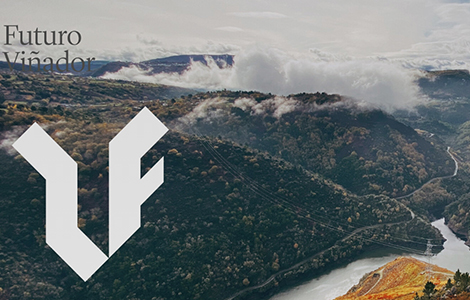BWW: a new wine fair for all sorts of Spanish producers

The successor of Intervin, the wine section of the mammoth Alimentaria food and wine fair, BWW was conveniently held in Montjuïc convention centre, in the centre of Barcelona, and hosted large and small wine producers from all over Spain. If there were any doubts about the diversity of winemaking styles, grape varieties and terroirs that are currently being bottled in Spain, Barcelona Wine Week has served to dispel them.
After taking on board the opinions of many small growers for their reasons to be absent from Alimentaria, BWW was conceived as a space for Spanish producers from all walks of life. The striking contrast between the two ends of Hall 8 offered an accurate image of what Spanish wine is today. The luxurious stands of the large groups versus the modest but lively area where the vignerons poured their wines.
In between the two, the rest of the fair featured identical structures in light, relaxing tones that were easily accessible for visitors. Producers were grouped by region. Each region was clearly marked by huge signs hanging from the ceiling and showing beautiful landscapes of each area. Corpinnat, the association of sparkling producers that left DO Cava, was one of the most significant novelties.
The way in which the producers decided to locate their stands at BWW is a statement in itself. The Torres family, for example, chose to host visitors in small stands distributed by regions rather than build a large single stand. Bodegas Pujanza, a respected name in Rioja, blended in with the small producers. Calling themselves Artisan Wine Attraction, 69 small bodegas joined forces defending sustainability, respect for the soil and the environment and the recovery of terroirs, grape varieties and traditional winemaking. With their black aprons embroidered with a pink logo and designed for the occasion, artisan producers were easily spotted.
Many visitors and exhibitors we talked to described the fair as "European" and "professional" but opinions differed when asked about the presence of importers and wine buyers. While some felt that more work was needed on this issue, others seemed happy to have opened new markets.
Some elements that contributed to create a warmer atmosphere were the spectacular suspended installation by Nika López made with materials taken from the vineyard, a meeting area and a bookstore (we wine writers really appreciated it) selling many interesting new releases both in Spanish and English.
The BWW Gastronomy area made it easier to recharge batteries with food that was miles better than the generally uninspiring victuals found at fairs worldwide. In partnership with several Barcelona restaurants like Gresca, Xerta or Monocrom, visitors were able to enjoy a seven-course tapas menu paired with seven wines for €29 -in fact, quantities were generous enough to be shared between two people. Wouldn’t it be nice if food-focused fairs paid as much attention to wine as BWW has paid to the solid part?
During the three days of the fair, talks and tastings were held in Speaker's Corner and two tasting rooms -both Speaker’s Corner and one of the tasting rooms were in the open so they had to endure the ambient noise. The larger tasting room, in a separate space, was quieter allowing for a quieter experience. The programme of talks and tastings was really extensive and SWL took part in a round table on wine communication in digital media. However, judging from the latest wine fairs and conferences we have attended -and BWW was no exception- we have been left with the feeling that much of the agenda is marked by sponsors, particularly Regulatory Boards, and large groups. A little bit of extra creativity in this regard would be desirable, to be in line with the rest of the fair.
Our comings and goings at BWW
Although smaller than Intervin, any substantial concentration of interesting wines can be a frustrating experience -you know you will only be able to taste a tiny amount of all the wines on show. SWL chose to attend a few tastings and talks, discover new producers, take advantage of the presence of many Catalan producers to taste their wines and attend one of the events held outside Montjuïc: the Off The Record tasting organized by producers Fredi Torres and Marc Lecha.
Most of the events that used to be held in parallel with Intervin and Alimentaria repeated the experience with BWW, with the notable exception of La Música del Vi, the very popular event hosted by leading local merchant Vila Viniteca. The Off programme started on Sunday with the sixth edition of Mujeres del Vino, featuring wines made by women, which reached full capacity. It was followed on Monday by the DO Cebreros festival at a local restaurant and the G-Night party dedicated to Garnacha. BWW also tried to involve the general public with several activities hosted by the city’s retailers, bars and restaurants.
In terms of tastings, we enjoyed the one devoted to the wines from Massif de Garraf in Penedès. It provided an accurate description of this mountainous limestone mass overlooking Sitges and the Mediterranean sea featuring poor, shallow soils with little water retention. Although the wines failed to show a clear pattern, we found some common elements like their concentration and salty flavours. Two wines by Can Ràfols dels Caus showed a remarkable ageing potential: the firm, unoaked Gran Caus Blanco 2011 and the Caus Lubis Merlot 2004 which, despite being made with a decidedly untrendy variety in Spain (winemaker Carles Esteva said he would not plant it now), was in top form.

We really enjoyed the Wine and Rock ’n’ Roll tasting. It was hosted by three members of the band The Winedrinkers, all of them veterans of the wine trade: Juan Manuel Bellver (former rock critic, journalist and current director of Lavinia Spain), Pilar de Haya (singer and DJ and now at Lavinia Spain) and Federico Oldenburg, former rock player, journalist and wine critic. We were surprised by the discreet attendance to this fun tasting, packed with anecdotes about wine-loving rock ’n’ roll celebrities. Unsurprisingly, the best wines at the tasting were made by wine people rather than by musicians who have gone on to make wine. If you are interested in wine-inspired songs, Pilar De Haya compiled the excellent play list Wine & Rock BWW which can be downloaded on Spotify.

The programme also included a masterclass with Thomas Matthews, executive director of Wine Spectator, about the perception of Spanish wine in America. He devoted the first half an hour of his speech to recount his experiences as a young man in Spain as well as his background as a wine critic and his time working for Wine Spectator. It was a bit of a missed opportunity as the audience was probably expecting to hear his views about the challenges of Spanish wine in the US, possible strategies to improve sales or the 25% tariffs imposed by Trump in October last year. We do not know if he finally addressed these issues as we decided to venture again into the fair to carry on tasting.

The molecular pairings with cava was addressed to a full house. In a context of troubled times for sparkling wines in Catalonia, the DO Cava decided to focus on food pairing with the help of François Chartier. Originally from Canada but now living in Barcelona, Chartier has tracked the aromatic molecules found in different types of Cava and matched them to worldwide foods sharing the same aromatic profiles. The first stage is focused on Mexico, Perú, the US, Japan and countries with a Mediterranean diet. Beyond the interest that his findings might have for sommeliers and wine lovers, they will surely help to de-seasonalize cava consumption.

Off The Record is one of the most interesting events on the fringes of BWW. It was held in a lovely space filled with natural light, which on a 'normal' day is a flower store, just three metro stops from the fair. It featured 32 small producers, some of whom were also pouring their wines at BWW like Colet, Arrayán, Verónica Ortega, Akilia, Julia Casado, Beatriz Herranz (Barco del Corneta) or Lagravera (Costers del Segre, Lleida). Biodynamic producer Lagravera only brought their La Pell wines produced from a vineyard planted in 1889 with up to 24 different grape varieties some of which are unknown. We were especially charmed by the finesse and purity of the rosé La Pell Clar although its limited production (300 bottles) and price (around €100) place it in the unicorn category of wines. Other favourite wines at this tasting, ably organized by producers Fredi Torres and Marc Lecha, were the Macabeo (Viura) wines made by Oriol Pérez de Tudela (Vinyes del Tiet Pere) in Tarragona, La Furtiva El Tossal, a single vineyard, skin-contact Garnacha Blanca with a veil of flor made by young producer Òscar Navas in Terra Alta, and the new vintage of Xerico by Roberto Oliván (Tentenublo) in Rioja Alavesa.

Other wines and styles we enjoyed
If the BWW were to take place again next week, we would probably recommend different wines. What follows is just a summary of some of our favourite sips.
The varied expressions of Garnacha Blanca by Bàrbara Forés. Carme Ferrer has found in her daughter Pili Sanmartín a talented successor. This women-run winery, which stands out for its work with Garnacha Blanca, could well host a masterclass of this grape variety based on its range of wines. This is what you feel when you taste side by side the elegant, classic El Quintà 2018 (a barrel aged white from pure sandy -panal- soils), the powerful, fleshy Abrisa't 2018 fermented with skins and aged in clay, and the captivating, terroir-driven, multi-layered En Moviment 1 2017. Part of their experimental range of wines, grapes for this wine are sourced from a 90-year-old vineyard planted on a hillside (coster).

Mallorca: three Manto Negro reds and a Gargollasa. It is not easy to taste wines from the Balearic Islands in mainland Spain. At BWW we had the chance to compare three different styles of Manto Negro produced in Mallorca: the delicate, yet complex, Burgundy-inspired Finca Biniagual 2018; the spicy, earthy Supernins 2018 grown at 400 metres above sea level in the Serra de Tramuntana, and the round, full, elegant Desconfío de la gente que no bebe (literally “I distrust people who do not drink”) from Bodega Ribas. We were also seduced by a subtle, expressive barrel sample of Gargollasa brought by Bárbara Mesquida. Although a complicated variety to grow and handle (“no wonder growers stopped planting it,” Bárbara pointed out), it delivers lovely fragrance and juiciness.

Los vinos de postal (Postcard wines). Espolla in Empordà is one of the few areas where Cariñena Blanca is still widely grown in Catalonia. The local cooperative has released a lovely range of wines made with indigenous grapes and featuring beautiful labels reminiscent of the old postcards we used to send before the arrival of the Internet. One of the first cooperatives in Catalonia, it is encouraging to see how it has adapted to the times and offer, in addition to high-volume wines, small pieces of the landscape and character of Empordà, giving relevance to the most unique vineyards of its members.

La vie en rose. Quality rosés are on the rise in Spain. Escabeces 2017, our wine of the week, tasted at the Off The Record show, impressed us as much as the Rosa d'Amfora Finca Olivardots, an incredible Cariñena aged in clay jars which retails for €12 in Spain. And why aren’t there more sparkling wines and rosés made with Sumoll? This indigenous variety, which was temporarily banned in DO Penedès, is living a renaissance in the area, but producers have to deal with its tannic and rustic edges. The Mas Candí Prohibit Brut Nature Corpinnat, a firm and super fresh sparkling rosé, could well lead the way.

Alto Turia anyone? It has been a long time since we tasted wines from this inland area in the far northwest of the province of Valencia where Merseguera is the dominant white variety. Fortunately, two wineries, Baldovar and Terra d'Art, had a stand in the small producers’ area. With labels designed by Dani Nebot and wines produced in a revamped cooperative, Baldomar Cañada París 2018 is a great introduction to Merseguera. From Terra d'Art, we loved Finca El Maldito 2017, a Bobal made from its oldest vineyard grown on sandy, gravelly soils.

Standing up for Garnacha in Navarra. In you are interested in discovering new Garnacha producers beyond the likes of Artazu, Lupier and Viña Zorzal, we suggest trying three reds from different areas of this province. Made by Luis Moya, Ostoki 2018 is a fresh, pure, bright Garnacha. Grapes are sourced from an old vineyard overlooking the city of Pamplona which was formerly destined to produce “txakolingorri” (red txakoli). This is a very cold area resulting in a subtle, light-coloured red. In Valdizarbe, still in the northern part of Navarra, Nekeas produces great value Garnacha. Their classic old-vine El Chaparral 2017, is a fragrant, deep red which retails at just €11 in Spain. In Murchante, in the south, winemaker Luis Remacha makes Rochapel 2018, a rich, ripe, great value Garnacha for the local cooperative Campos de Enanzo, and the spicy, savoury Cientruenos 2017 for La Calandria Pura Garnacha, his personal project together with other partners. There is no oak in the latest vintage of Cientruenos; the wine is aged in stainless steel and clay jars.

A retired man from Castellón. Terroir-driven wines are not only made by young people. After taking early retirement, Vicente Flors decided to recover the family’s wine making tradition that his generation had skipped in Les Useres (Castellón). Wearing the Artisan Wine Attraction apron, he poured the original Clotàs E 2018 Bonicaire, an earthy but fresh and enveloping Monastrell made from 90-year-old vines (Clotàs M 2017) and the rich and polished Clotàs G 2018 Garnacha. Production stands between 500 to 2,000 bottles.

Vinos en Voz Baja: a small producer to watch. In line with his artisan philosophy (the name translates as “whispering wines”), his sedate character and his origin (Rioja Oriental, the least recognised area in the whole DO), Carlos Mazo occupied one of the corners of the small producers' sector. Despite his discreet presence, the personality of his wines is undeniable, such as his Costumbres 2018 Tinto, an attractive fresh Garnacha sourced from four different vineyards, made with whole clusters and aged in used barrels, or El Outsider 2018, which blends 80% Garnacha with Pasera (the local name for the white Calagraño). Made without sulphur and in demijohns, it displays pure aromas, earthy texture and a delicious sparkle in the palate.

Bienvenidos al extraordinario mundo de la mujer caballo (Welcome to the extraordinary world of the woman horse). Recovering native varieties always requires a good dose of patience and care. If this occurs in a lesser-known wine-producing area such as Valencia, the job is even more daunting. Under the very long name that appears in bold at the start of this paragraph, Pilar Esteve and José Ramón Domenech (Fil.loxera i Cía), growers in Fontanars dels Alforins, produce two reds and a food-friendly skin-contact white, the latter with the varieties Valencí (60%), Moscatel Romano (10%) and others as yet unidentified. The bottle with the blue label, made with Arco, a late-ripening red variety with good acidity, contains a fresh and elegant wine with polished tannins and excellent expression. The green sealed bottle is made with Ullet de Perdiu (partridge eye), a variety that is the first to be harvested in the estate and is planted in between Garnacha Tintorera vines. Thanks to its acidity and the way in which it is handled, its 15% abv. goes unnoticed.

New initiatives in Jerez. The mayetos or growers are still waiting for the much-vaunted Sherry revolution to materialise in their pockets, but no-one can deny the dynamism of a handful of producers who are aware that Jerez needs a new quality wine category to provide the economic sustenance for the great traditional sherries. This is what Willy Pérez (Bodegas Luis Pérez) was telling visitors gathered at his stand while they tasted La Escribana, an unfortified Palomino from the legendary Macharnudo vineyard that aspires to join the ranks of this new category that is now being discussed by the Regulatory Council. Aged in sherry casks, Pérez labels it as "vino de pasto", a term used in the old days to describe this style of albariza-grown wine and which he and other producers in the area would like to popularize. A different kettle of fish in terms of size and volume but always at the forefront of innovation, Barbadillo presented its new As (20,000 bottles, €10. Fermented in vats and with no oak, it is made from four old-vine Palomino vineyards with yields of 4,000 kg/ha. The wine retains the saline flavours of the area's wines but there is a greater presence of fruit, making it very accessible to the general public.


Amaya Cervera
A wine journalist with almost 30 years' experience, she is the founder of the award-winning Spanish Wine Lover website. In 2023, she won the National Gastronomy Award for Gastronomic Communication

Yolanda Ortiz de Arri
A journalist with over 25 years' experience in national and international media. WSET3, wine educator and translator
NEWSLETTER
Join our community of Spanish wine lovers






